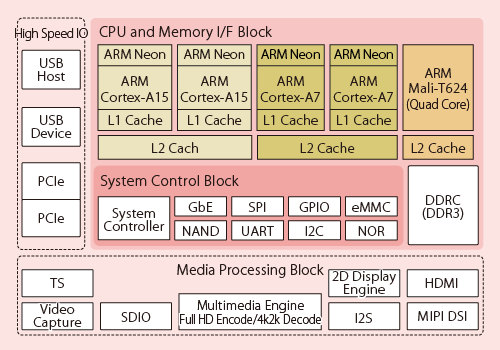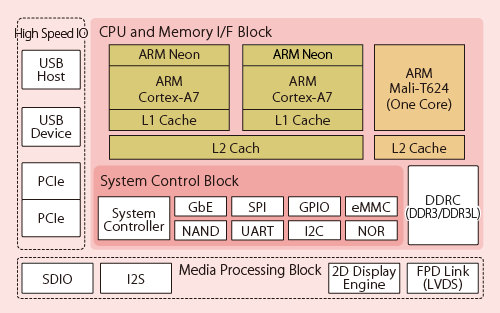I like to check the ARM Linux kernel mailing list from time to time, as you may discover a few upcoming ARM processors. This week I found out Exynos 5433 and Exynos 7 are actually two different processors (thanks David!), and that AMD had submitted code for their 64-bit ARM Opteron A1100 SoC for servers. I also noticed a patchset for Fujitsu MB86S7X SoCs, and since I don’t often mention Japanese silicon vendors, probably because they now mainly deal mostly with the embedded market that gets very little press, and most information is in Japanese, I decide to have a look.

There seems to be four SoC parts in MB86S7x family with MB86S70 quad core processor with two ARM Cortex A15 and two ARM Cortex A7 cores in big.LITTLE configuration, and MB86S73 with two ARM Cortex A7 cores only, as well as MB86S71/72 with 2x A15 and 2x A7, with all featuring a single or quad core Mali-T624 GPU.
Fujitsu provided a comparison tables for both MB86S70 and MB86S73 processors in English, but there’s very little info about MB86S71/72 SoCs.
| Block | Function | MB86S70 | MB86S73 |
|---|---|---|---|
| CSS DMC |
CPU | Cortex-A15 2 cores Up to 2.4GHz 1MB-L2C |
– |
| CPU | Cortex-A7 2 cores up to 800MHz 256k-L2C |
Cortex-A7 2 cores up to 1.2GHz 512k-L2C |
|
| 3D/GPGPU | Mali-T624 4 cores @ 400MHz 128k-L2C |
Mali-T624 1 core @400MHz 32k-L2C |
|
| MEMC | 2-ch DDR3-1.333Gbps 32bit | 1-ch DDR3-1.333Gbps 64bit | |
| SCB | CPU | ARM Cortex M3 @ 125MHz | ARM Cortex M3 @ 125MHz |
| LAN | GbE, WoL, TCP Acceleration | GbE, WoL, TCP Acceleration | |
| FLASH-IF | HSSPI, NOR, eMMC, NAND SecureBoot (SROM/NOR) |
HSSPI, NOR, eMMC, NAND SecureBoot (SROM/NOR) |
|
| SERIAL-IF | 3x UART, 16x GPIO, 10x I2C | 3x UART, 16 GPIO, 3x I2C | |
| MPB | CODEC | 1080p Multi Encode, 4 stream H.264 Decode 32k × 32k JPEG CODEC |
32k × 32k JPEG CODEC |
| Display | HDMI-1.4a HDCP MIPI-DSI 1Gbps-4Lane |
LVDS (CLK 1ch / data 4ch) | |
| CAPTURE | 1-ch RBG/YUV 720p capture only | – | |
| TSIF | 2 serial TS Demux | – | |
| AUDIO | 2-ch I2S (I/O Independent) + 4ch I2S (HDMI) |
2-ch I2S (I/O Independent) | |
| SD | 1-ch SDIO UHS-I | 1ch SDIO UHS-I | |
| HSIOB | PCIe | 2-ch PCIe-Gen2-4Lane + Data Scrambler | 2-ch PCIe-Gen2-4Lane + Data Scrambler |
| USB | USB3 Host | 2ch USB3 Host | |
| USB | USB2 HDC | 1ch USB2 Host, 1ch USB2 Device |
MB86S70 is the more powerful of the two, not only when it comes with CPU power, but also with regards to multimedia capabilities with 1080p encode, and 4-k encode, TS demux, and RGB/YUV 720p video capture, whereas MB86S73 does not seem to support hardware video decoding / encoding at all, providing only JPEG acceleration, and an LVDS interface, so it’s mostly probably desinted to be used in control panels for example. Both processors however feature high-speed interfaces like USB 3.0 host, Ggiabit Ethernet, and PCI-E interface, the latter being not so common in ARM SoCs, and only found in a few products like Freescale i.MX6 and Tegra K1 SoCs.

The company also provides evaluation boards for their two processors, together with a software development platform based on Linux with support for OpenGL, OpenCL, and OpenMAX for graphics and video decoding, and they’ve also started getting some code to mainline kernel.

More information is available in Japanese only on Fujitsu’s Platform SoC page, and a presentation (PDF) made at Java Day Tokyo 2014.

Jean-Luc started CNX Software in 2010 as a part-time endeavor, before quitting his job as a software engineering manager, and starting to write daily news, and reviews full time later in 2011.
Support CNX Software! Donate via cryptocurrencies, become a Patron on Patreon, or purchase goods on Amazon or Aliexpress




